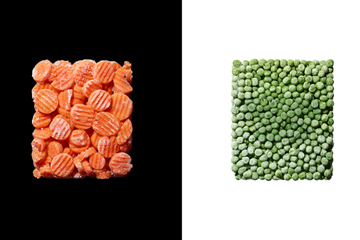
(2 of 6)
So let's take a tour of the supermarket in search of everyday foods we can reclaim as stalwarts of a healthy diet. We'll pick up some meat and some snacks too, and we'll do a fair amount of label reading as we go. We'll even make a stop at the ice cream section. (I promise.) But let's start in the most underrated aisle of all: frozen foods.
Frozen, Canned--and Good?
It was in the 1920s that the idea of freezing fresh vegetables into preserved, edible rectangles first caught hold, when inventor Clarence Birdseye developed a high-pressure, flash-freezing technique that operated at especially low temperatures. The key to his innovation was the flash part: comparatively slow freezing at slightly higher temperatures causes large ice crystals to form in food, damaging its fibrous and cellular structure and robbing it of taste and texture. Birdseye's supercold, superfast method allowed only small crystals to form and preserved much more of the vitamins and freshness.
In the 90 years since, food manufacturers have added a few additional tricks to improve quality. Some fruits and vegetables are peeled or blanched before freezing, for example, which can cause a bit of oxidation--the phenomenon that makes a peeled apple or banana turn brown. But blanching also deactivates enzymes in fruit that would more dramatically degrade color as well as flavor and nutrient content. What's more, the blanching process can actually increase the fibrous content of food by concentrating it, which is very good for human digestion.
Vitamin content is a bit more complex. Water-soluble vitamins--C and the various B's--degrade somewhat during blanching but not when vegetables are steamed instead. Steaming is preferable but it takes longer, and many manufacturers thus don't do it. The package will tell you how the brand you're considering was prepared. Other vitamins and nutrients, including carotenoids, thiamin and riboflavin, are not at all affected by freezing, which means you can eat frozen and never feel that you are shortchanging yourself.
Canning is an even older type of preservation; it's also quite possibly the single most significant technological leap in food storage ever conceived. Developed in the early 19th century by an inventor working for the French navy, canning is a two-step process: first, heat foods to a temperature sufficient to kill all bacteria, and then seal them in airtight containers that prevent oxidation. Not all food comes out of the can as appetizing as it was before it went in. Some fruits and vegetables do not survive the 250F heating that is needed to sterilize food and can become soft and unappetizing. And in decades past, food manufacturers had way too free a hand with the salt shaker. That is not the case any longer for all brands of canned foods. A simple glance at the nutrition label (which itself didn't exist in the salty old days) can confirm which brands are best.
